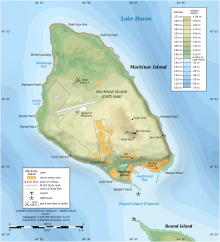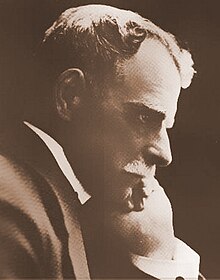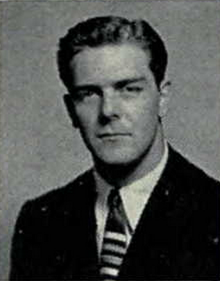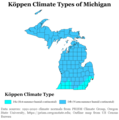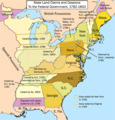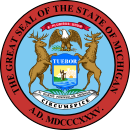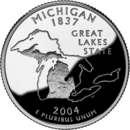The Michigan Portal  Michigan (/ˈmɪʃɪɡən/ ⓘ MISH-ig-ən) is a state in the Great Lakes region of the Upper Midwestern United States. It borders Wisconsin to the northwest in the Upper Peninsula, and Indiana and Ohio to the south in the Lower Peninsula; it is also connected by Lakes Superior, Michigan, Huron, and Erie to Minnesota and Illinois, and the Canadian province of Ontario. With a population of nearly 10.12 million and an area of 96,716 sq mi (250,490 km2), Michigan is the 10th-largest state by population, the 11th-largest by area, and the largest by area east of the Mississippi River. Its capital is Lansing, and its largest city is Detroit. Metro Detroit is among the nation's most populous and largest metropolitan economies. The name derives from a gallicized variant of the original Ojibwe word ᒥᓯᑲᒥ (mishigami), meaning "large water" or "large lake". Michigan consists of two peninsulas. The Lower Peninsula resembles the shape of a mitten, and comprises a majority of the state's land area. The Upper Peninsula (often called "the U.P.") is separated from the Lower Peninsula by the Straits of Mackinac, a five-mile (8 km) channel that joins Lake Huron to Lake Michigan. The Mackinac Bridge connects the peninsulas. Michigan has the longest freshwater coastline of any political subdivision in the United States, being bordered by four of the five Great Lakes and Lake St. Clair. It also has 64,980 inland lakes and ponds. Michigan has the second-most water area of any state, behind only Alaska. The area was first occupied by a succession of Native American tribes over thousands of years. In the 17th century, French explorers claimed it as part of the New France colony, when it was largely inhabited by indigenous peoples. French and Canadian traders and settlers, Métis, and others migrated to the area, settling largely along the waterways. After France's defeat in the French and Indian War in 1762, the region came under British rule. Britain ceded the territory to the newly independent United States after its defeat in the American Revolutionary War. The area was part of the larger Northwest Territory until 1800, when western Michigan became part of the Indiana Territory. Michigan Territory was formed in 1805, but some of the northern border with Canada was not agreed upon until after the War of 1812. Michigan was admitted into the Union in 1837 as the 26th state, a free one. It soon became an important center of industry and trade in the Great Lakes region, attracting immigrants in the late 19th and early 20th centuries from many European countries. Immigrants from Finland, Macedonia, and the Netherlands were especially numerous. Migration from Appalachia and of Black Southerners as part of the Great Migration increased in the 1930s, with many settling in Metro Detroit. (Full article...) Entries here consist of Good and Featured articles, which meet a core set of high editorial standards.
Mackinac Island (/ˈmækənɔː/ MAK-ə-naw, locally /ˈmækənə/ MAK-ə-nə; French: Île Mackinac; Ojibwe: Mishimikinaak ᒥᔑᒥᑭᓈᒃ; Ottawa: Michilimackinac) is an island and resort area, covering 4.35 square miles (11.3 km2) in land area, in the U.S. state of Michigan. The name of the island in Odawa is Michilimackinac and "Mitchimakinak" in Ojibwemowin, meaning "Great Turtle". It is located in Lake Huron, at the eastern end of the Straits of Mackinac, between the state's Upper and Lower Peninsulas. The island was long home to an Odawa settlement and previous indigenous cultures before European colonization began in the 17th century. It was a strategic center of the fur trade around the Great Lakes. Based on a former trading post, Fort Mackinac was constructed on the island by the British during the American Revolutionary War. It was the site of two battles during the War of 1812 before the northern border was settled and the US gained this island in its territory. In the late 19th century, Mackinac Island became a popular tourist attraction and summer colony. Many of the structures on the island have undergone extensive historical preservation and restoration. Because of its historic significance, the entire island is listed as a National Historic Landmark. It is well known for numerous cultural events; a wide variety of architectural styles, including the Victorian Grand Hotel; and its ban on almost all motor vehicles, with exceptions only for city emergency vehicles (ambulance, police cars and fire trucks), city service vehicles and snowmobiles in winter. More than 80 percent of the island is preserved as Mackinac Island State Park. (Full article...)Selected picture - The Huron-Manistee National Forests are actually two National Forests combined in 1945 for administration purposes and which comprise 978,725 acres (3,960 km2) of public lands, including 5,786 acres (23 km2) of wetlands, extending across the northern Lower Peninsula of Michigan. Did you know -
Related portalsSelected article -
Albert May Todd (June 3, 1850 – October 6, 1931), known as "The Peppermint King of Kalamazoo," was an American chemist, businessman, and politician from the state of Michigan. A philanthropist and advocate of public ownership of utilities, Todd made his fortune as the founder of the A.M. Todd Company, a world leader in the production of peppermint oil and other botanical extracts. Todd was also a renowned bibliophile, portions of whose collection now grace the holdings of several American universities. He served one term in the United States House of Representatives. (Full article...)
Selected biography -Richard Gale Rifenburg (August 21, 1926 – December 5, 1994) was an American football player and a pioneering television broadcaster for the forerunner to WIVB-TV in Buffalo. He played college football for the University of Michigan Wolverines in 1944 and from 1946 to 1948. He was a consensus selection at end on the 1948 College Football All-America Team. Rifenburg played professionally in the National Football League (NFL) with the Detroit Lions for one season in 1950. After retiring from football he settled in Buffalo and became a sports broadcaster. He worked as a color commentator and as a play-by-play announcer for the Buffalo Bulls. He hosted various television and radio sports shows and was eventually inducted into the Buffalo Broadcasters Hall of Fame. In college, he led the Big Ten Conference in single season receptions during his senior year and set Michigan Wolverines receptions records for both career touchdown and single-season touchdowns. He had also been a Michigan High School Athletic Association (MHSAA) state champion in both basketball and track and field. His college career was interrupted by World War II service, and his high school career was also affected by the war due to the MHSAA's cancellation of state championships in all sports in 1943. (Full article...)General imagesThe following are images from various Michigan-related articles on Wikipedia.
TopicsCategoriesSymbols
Lists
Related pagesWikimediaThe following Wikimedia Foundation sister projects provide more on this subject:
Things you can doDiscover Wikipedia using portals
Purge server cache
| ||||||||||||||||||||||||||||||||||||

Sons of Union Veterans of the Civil War

